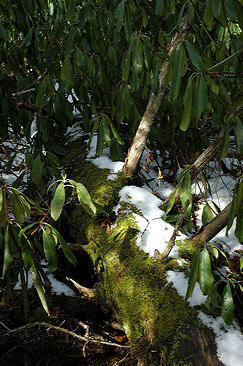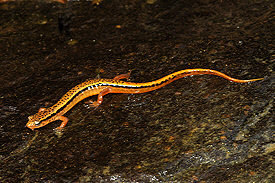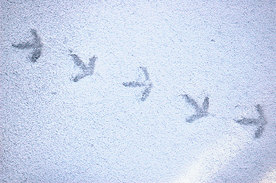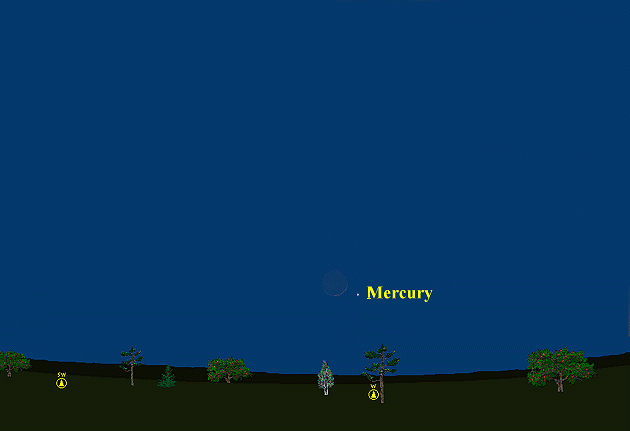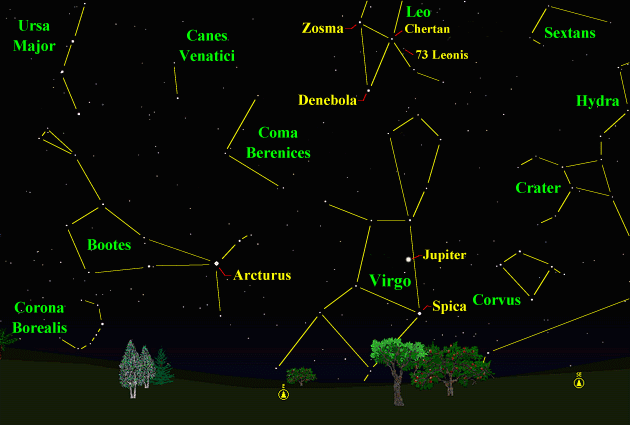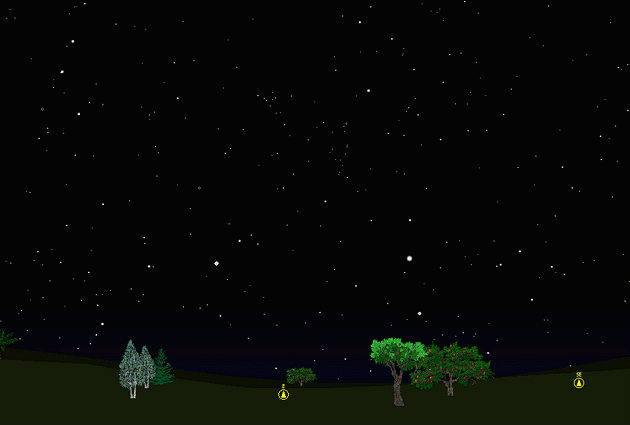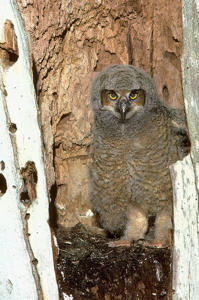The purpose of this feature is to give scout leaders, educators and naturalists an idea of some of the natural events coming up each month. We will try to cover a variety of natural events ranging from sky events to calling periods of amphibians, bird and mammal watching tips, prominent wildflowers and anything else that comes to mind. We will also note prominent constellations appearing over the eastern horizon at mid-evening each month for our area for those who would like to learn the constellations. If you have suggestions for other types of natural information you would like to see added to this calendar, let us know! Note: You can click on the hyperlinks to learn more about some of the featured items. To return to the Calendar, hit the "back" button on your browser, NOT the "back" button on the web page. Notes and Images From February 2005: Along a Mountain Stream in Winter:
We visit the Blue Ridge Mountains near Cherokee, North Carolina each month to do a survey of birds, reptiles and amphibians. Though it seems pretty quiet in February at an elevation of 5,000 feet, we found Ruffed Grouse and Black Bear tracks in the snow. Mountain salamanders like the Blue Ridge Two-lined Salamander dwell in and along the high-altitude streams.
Winter Buds in February:
The image of Eastern Hophornbeam buds at right was made at the Wilderness Station in Murfreesboro, TN. Now is a great time to get out and watch the progression from bud to flowers and fruit, and to watch the leaves unfold. Amphibians in February: During warm periods last month, the Southeastern Chorus Frogs at our farm called non-stop day and night. We also heard Southern Leopard Frogs, and we found one corner of our pond filled with Southern Leopard Frog egg masses. On our route for the Tennessee Amphibian Monitoring Program, on February 20th, we heard Spring Peepers and Southeastern Chorus Frogs, and saw American Toads and one Pickerel Frog. On February 1st, watching a Great Blue Heron rookery, I observed Great Blue Herons displaying courtship behavior and saw one rearranging sticks in a nest.
Sky Events for March 2005: Evening Sky: Mercury has a fine apparition in March, the best of the year. The view below shows it on March 11th, when it will be very near a young crescent moon. Mercury reaches maximum elongation from the sun on March 12th. Start looking for it in the western sky about 30 minutes after sunset. A flat western horizon will extend your viewing time.
Saturn remains bright and beautiful in the Constellation Gemini, near the bright stars Castor and Pollux. Almost any small telescope will yield stunning views of this ringed planet. Jupiter rises about 7:30pm CST at mid-month, and shines above the bright star Spica in the constellation Virgo. Morning Sky: The moon occults the bright star Antares, in Scorpius, in the early morning hours of March 3rd. The star will disappear behind the bright limb of the moon around 10:45 UT, or 4:45am CST. Watch for it to reappear in twilight around 12:07 UT, or 6:07am CST. Antares is a double star, and if you carefully watch the dark limb of the moon, you may see its faint companion, Antares B, reappear from behind the moon about 5 seconds before the Antares A blazes back into view. You will need a telescope or binoculars to have much chance of seeing Antares B. The companion to Antares was discovered in exactly this way, during a lunar occultation of Antares in the early 1800's. Mars rises about 3:10am CST at mid-month. The red planet is steadily growing brighter as the earth starts to draw nearer. The earth's closest approach to Mars will be next fall. Now it still appears very small in telescopic views. All times noted in the Sky Events are for Franklin, Tennessee and are Central Standard Time. These times should be pretty close anywhere in the mid-state area.
Constellations: The views below show the sky looking east at 9:00pm CST on March 15th. The first view shows the sky with the constellation outlines and names depicted. Star and planet names are in yellow. Constellation names are in green. The second view shows the same scene without labels. To download each chart in a format that will not drain your printer of black ink, simply click on each chart. All 5 planets are visible in the early evening sky towards the end of the month. The bright star Arcturus, in Bootes, the Herdsman, makes its appearance this month in the early evening sky, a sure sign that Spring is here. Below Bootes is Corona Borealis, the Northern Crown. In the southeast, Virgo clears the horizon this month along with Corvus, the Crow. Find Denebola, the star that marks the tip of the tail of Leo, the lion. Now locate the stars Zosma and Chertan, above Denebola, which along with Denebola make a conspicuous triangle of bright stars. If you mentally draw a line from Zosma to Chertan, and extend it about one third of the distance between these two stars, you should see a faint star known as 73 Leonis (refer to the image below - unless you're looking from a dark sky location, you will probably need binoculars to see 73 Leonis.) You can put your telescope on 73 Leonis, turn off your clock drive, and let the earth's rotation slowly take you into the Virgo Cluster of Galaxies. For a description of how to do this, refer to our March 2004 Natural Calendar (Drifting Through a Galaxy Cluster). One caution; if you haven't used your telescope recently, the first thing you need to do is sight in your finder telescope. Use a bright star (like Regulus) to adjust your finder scope, so that when the finder cross hairs are on Regulus, the star is centered in the main telescope's field of view. If you don't do this before trying to find 73 Leonis, you may waste a lot of time trying to figure out which star it is in your telescope's field of view.
On Learning the Constellations: We advise learning a few constellations each month, and then following them through the seasons. Once you associate a particular constellation coming over the eastern horizon at a certain time of year, you may start thinking about it like an old friend, looking forward to its arrival each season. The stars in the evening scene above, for instance, will always be in the same place relative to the horizon at the same time and date each March. Of course, the planets do move slowly through the constellations, but with practice you will learn to identify them from their appearance. In particular, learn the brightest stars (Like Arcturus and Denebola in the above scene looking east), for they will guide you to the fainter stars. Once you can locate the more prominent constellations, you can "branch out" to other constellations around them. It may take you a little while to get a sense of scale, to translate what you see on the computer screen or what you see on the page of a book to what you see in the sky. Look for patterns, like the stars of the "Big Dipper." The earth's rotation causes the constellations to appear to move across the sky just as the sun and the moon appear to do. If you go outside earlier than the time shown on the charts, the constellations will be lower to the eastern horizon. If you observe later, they will have climbed higher. As each season progresses, the earth's motion around the sun causes the constellations to appear a little farther towards the west each night for any given time of night. If you want to see where the constellations in the above figures will be on April 15th at 9:00pm CST, you can stay up till 11:00pm CST on the March 15th and get a preview. The westward motion of the constellations is equivalent to two hours per month. A good book to learn the constellations is H. A. Rey's classic, The Stars, A New Way to See Them. Rey's depictions of the constellations and witty commentary are terrific. A good general reference book on astronomy is the Peterson Field Guide, A Field Guide to the Stars and Planets, by Pasachoff. The book retails for around $14.00. A good beginners software program for learning the night sky is the Starry Night Beginner program. Visit the Starry Night web site at www.starrynight.com The program retails for around $30.00 and contains a wealth of information.
Circumzenithal Arcs: Fall, Winter and Spring are good times to watch for these beautiful arcs that form directly overhead. Be sure to look upward in the late afternoon anytime you have wispy cirrus clouds in sky.
Amphibians:
When the temperatures start to rise in March, much frog and toad song can be heard. Our Southeastern Chorus Frogs at the farm are calling continuously, day and night. Spring Peepers and Southern Leopard Frogs, are also already calling this year. American Toads, if you have not heard them yet, should be calling soon. Look for their eggs. In West Tennessee, Northern Crawfish Frogs give their loud snoring calls in early March. At higher elevations, listen for Mountain Chorus Frogs. Towards the end of the month listen for Pickerel Frogs doing their "yeeooow" call. Remember that on mild nights you may find frogs and toads out foraging that you do not hear until later in the season.
Birds:
This time of year is prime time to find owl nests. Since the leaves have not yet appeared on most trees, you can sometimes spot the old stick nests that the owls often use for nesting. This year I spotted a Great Horned Owl on the nest on January 24th, while driving along the interstate. Observe only at a distance and do not try to approach a nest, both for your own safety and to keep from flushing the owl off the eggs. The adult's absence, if it flushes, can allow the eggs to rapidly get too cold, and may doom the nest. Look and listen for the young Great Horned Owls. If you find a young owl on the ground, leave it there! Its parents will feed it on the ground. Well-meaning people sometimes take young owls they find on the ground to wildlife rehabilitation centers, thinking the young owls have been abandoned. This is not necessary, and it may prevent the owl from ever successfully living in the wild. Don't do it.
Recommended: Bird Finding in Tennessee, Michael Lee Bierly. A classic guide to finding birds in Tennessee. The Sibley Guide to Birds, David Allen Sibley The Sibley Guide to Birds of Eastern North America, David Allen Sibley This new Sibley Guide covers only eastern North America, is quite compact, and is less expensive than the larger Sibley. An inexpensive guide for beginners is the Golden Guide for Birds.
Archives (Remember to use the back button on your browser, NOT the back button on the web page!)
Natural Calendar
February 2005
Natural Calendar
December 2004
Natural Calendar
November 2004
Natural Calendar
September 2004
Natural Calendar
February 2004
Natural Calendar
December 2003
Natural Calendar
November 2003
Natural Calendar
September 2003
Natural Calendar
February 2003
Natural Calendar
December 2002 Natural Calendar November 2002
Nature Notes Archives: Nature Notes was a page we published in 2001 and 2002 containing our observations about everything from the northern lights display of November 2001 to frog and salamander egg masses. All Photographs © 2005 Leaps Night scenes prepared with Starry Night Pro software
|
||||||||||||||||||||||
